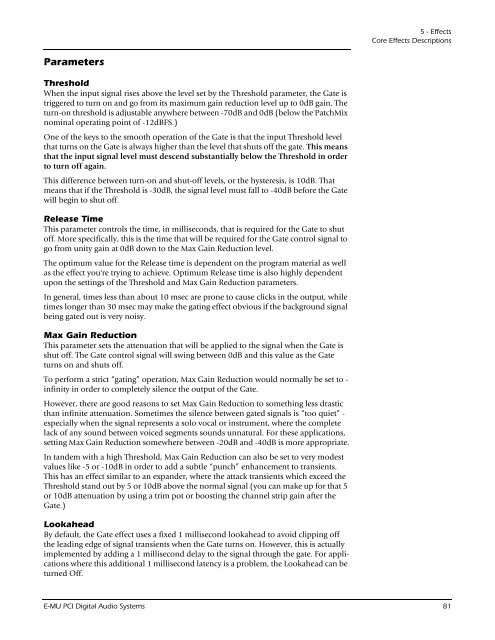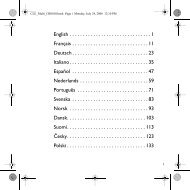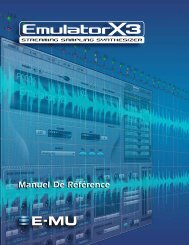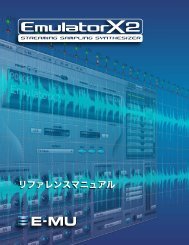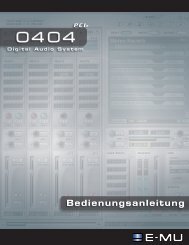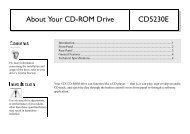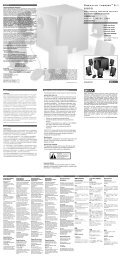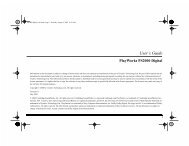Create successful ePaper yourself
Turn your PDF publications into a flip-book with our unique Google optimized e-Paper software.
Parameters<br />
Threshold<br />
When the input signal rises above the level set by the Threshold parameter, the Gate is<br />
triggered to turn on and go from its maximum gain reduction level up to 0dB gain. The<br />
turn-on threshold is adjustable anywhere between -70dB and 0dB (below the PatchMix<br />
nominal operating point of -12dBFS.)<br />
One of the keys to the smooth operation of the Gate is that the input Threshold level<br />
that turns on the Gate is always higher than the level that shuts off the gate. This means<br />
that the input signal level must descend substantially below the Threshold in order<br />
to turn off again.<br />
This difference between turn-on and shut-off levels, or the hysteresis, is 10dB. That<br />
means that if the Threshold is -30dB, the signal level must fall to -40dB before the Gate<br />
will begin to shut off.<br />
Release Time<br />
This parameter controls the time, in milliseconds, that is required for the Gate to shut<br />
off. More specifically, this is the time that will be required for the Gate control signal to<br />
go from unity gain at 0dB down to the Max Gain Reduction level.<br />
The optimum value for the Release time is dependent on the program material as well<br />
as the effect you're trying to achieve. Optimum Release time is also highly dependent<br />
upon the settings of the Threshold and Max Gain Reduction parameters.<br />
In general, times less than about 10 msec are prone to cause clicks in the output, while<br />
times longer than 30 msec may make the gating effect obvious if the background signal<br />
being gated out is very noisy.<br />
Max Gain Reduction<br />
This parameter sets the attenuation that will be applied to the signal when the Gate is<br />
shut off. The Gate control signal will swing between 0dB and this value as the Gate<br />
turns on and shuts off.<br />
To perform a strict “gating” operation, Max Gain Reduction would normally be set to -<br />
infinity in order to completely silence the output of the Gate.<br />
However, there are good reasons to set Max Gain Reduction to something less drastic<br />
than infinite attenuation. Sometimes the silence between gated signals is “too quiet” -<br />
especially when the signal represents a solo vocal or instrument, where the complete<br />
lack of any sound between voiced segments sounds unnatural. For these applications,<br />
setting Max Gain Reduction somewhere between -20dB and -40dB is more appropriate.<br />
In tandem with a high Threshold, Max Gain Reduction can also be set to very modest<br />
values like -5 or -10dB in order to add a subtle “punch” enhancement to transients.<br />
This has an effect similar to an expander, where the attack transients which exceed the<br />
Threshold stand out by 5 or 10dB above the normal signal (you can make up for that 5<br />
or 10dB attenuation by using a trim pot or boosting the channel strip gain after the<br />
Gate.)<br />
Lookahead<br />
By default, the Gate effect uses a fixed 1 millisecond lookahead to avoid clipping off<br />
the leading edge of signal transients when the Gate turns on. However, this is actually<br />
implemented by adding a 1 millisecond delay to the signal through the gate. For applications<br />
where this additional 1 millisecond latency is a problem, the Lookahead can be<br />
turned Off.<br />
5 - Effects<br />
Core Effects Descriptions<br />
E-MU PCI Digital Audio Systems 81


